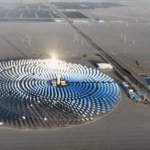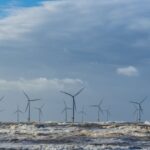Energy News Beat
GANSU, China: Chinese farmer Wu Wenju lives in a little house that is unassuming except for the 48 solar panels installed on its roof, glistening in the midday sun.
His family own a cotton and sheep farm in a village in Dunhuang, Gansu province. And the solar panels provide an additional source of income: A power company installed them for free and rents the roof space from the family.
The electricity generated is connected to the local grid but is also made available to the family, free of charge.
“Normally, our … electricity consumption is about 100 yuan (S$19) per month,” says Wu. “We can save about a few hundred yuan a year now.”
Not all the families in his village have installed solar panels at this point, but more are warming to the idea. Indeed, in the past few years, more villagers across China have done something similar.
Through the government’s Solar Energy for Poverty Alleviation Programme (SEPAP), announced in 2014, home owners lease their roof and land to solar companies. The electricity generated is sold to the grid, with profits shared with the home owners.
Solar panels on the rooftop of a house in Wu Wenju’s village.
He Jijiang, executive deputy director of Tsinghua University’s Research Centre for Energy Transition and Social Development, described this programme as “one of China’s signature energy transformations”.
“(Photovoltaics) are built in the poorest villages, and income generated from the power stations is reserved for the villagers to address poverty issues,” he said.
SEPAP has benefited more than 400 million people, according to China’s National Energy Administration. And by 2020, the programme increased national solar power capacity by 26 gigawatts, exceeding the initial target of 10 gigawatts.
This April, China’s solar capacity reached 430 gigawatts, which is triple that of second-placed United States, with 142 gigawatts.
China has invested heavily in other renewables too. In 2012, the country saw US$67.7 billion (S$90.2 billion) of clean energy investment. A decade later, this shot up to US$546 billion.
Today, China is the world’s biggest producer of renewable energy, and not only solar energy.
It has more than 4,300 wind farms in operation or development. Last year, these generated 46 per cent more wind power than all of Europe, the second-largest wind generation market.
Despite these achievements, there are inherent contradictions. China is the world’s biggest climate polluter and permitted more coal power stations last year than any time since 2015.
Why is this the case? The programme Insight finds out the true story of China’s green energy revolution and whether the world has something to worry about.
WATCH: China’s contradiction: World’s biggest clean energy producer and biggest polluter? (45:21)
“If you were here back in 2013, you probably had to wear masks, not because of COVID but because of the (air pollutants),” said Ma Jun, former chief economist of China’s central bank, the People’s Bank of China.
Ma, who is now the president of the non-profit Institute of Finance and Sustainability, helped draft China’s first green finance guidelines.
He noted that dealing with pollution — not only air but also water and land pollution — required “a lot of money”: About 4 trillion yuan yearly.
China has had to deal with air pollutants such as nitrogen oxides and sulfur oxides.
But experts attribute China’s growing motivations to economic reasons as much as the environment. While more than 80 per cent of the world’s solar cells are made in China today, there was no domestic market at the start.
“It was mostly the European demand that triggered China’s investment in the whole renewable energy sector,” said Hang Seng Bank (China) chief economist Wang Dan.
It was in 2006, with the start of the European photovoltaic market and the support of a series of European policies, when China’s photovoltaic cell industry’s technology began to advance.
Back then, China bought raw materials from overseas and used foreign technology to process photovoltaics domestically before exporting them.
“Because of the lower costs in China, … (Chinese photovoltaic companies) could quickly become profitable and raise the funds for rapid factory expansion,” said Solar Energy Research Institute of Singapore chief executive officer Armin Aberle.
Perhaps most emblematic of China’s green investments is Dunhuang’s molten salt solar thermal power station, known as the “super mirror power plant”, on the doorstep of Wu’s village.
Built at a cost of 3 billion yuan, it covers 7.8 square kilometres in the Gobi Desert — the size of almost 1,100 football fields and the largest of its kind in China.
The 100-megawatt station can generate over 2.3 million kilowatts per day, enough to supply electricity to Dunhuang city for a whole day, said its general manager, Liu Fuguo.
The station uses 12,000 photovoltaic mirrors to concentrate and reflect sunlight onto a receiver tower. Molten salt is pumped into the tower and then heated.
With no shortage of direct sunlight and very little cloud cover, the arid Gobi Desert is the ideal location for Dunhuang’s solar thermal power station.
Whereas conventional photovoltaics convert sunlight into electricity, which means the electricity generation stops once the sun has set, the station’s technology is different, according to Liu.
“During the day, the electricity generation process collects and stores the heat,” he said. “After the sun sets, the stored heat continues to generate electricity.”
THE COAL ATTRACTION
Even as China constructs clean energy projects such as Dunhuang’s solar thermal power station, it is responsible for about 30 per cent of global emissions, largely because of its dependence on coal.
China is also building more coal power stations than any other country. Last year, it produced a record 4.5 billion metric tons of coal, Reuters reported.
Despite its clean energy investment, experts note that coal is still the lowest-cost energy option in China today.
“China sits on huge reserves of coal,” said Aberle. “It doesn’t want to import energy from other countries; it wants to use as much local coal as possible. … That’s why coal is so attractive.”
China’s energy system is dominated by coal.
Clean energy generation, added Wang, is also “mostly intermittent”, which means there is no better alternative to coal power for heating.
“(You) need to have continued sunshine or continuous wind blowing in order to generate enough of the (power) supply,” she said. “If you build one more power plant using solar or wind, you almost have to build a separate coal power plant in order to stabilise the power supply.
“So a coal power plant in many areas of China is simply a necessity.”
Moreover, in China, economic growth “dominates everything”, and the environment “comes second”, said Aberle. “I don’t think they’re ready to serve as a global role model in the sustainability arena.”
The post China’s clean energy revolution a contradiction in terms? A few truths about its green story appeared first on Energy News Beat.








